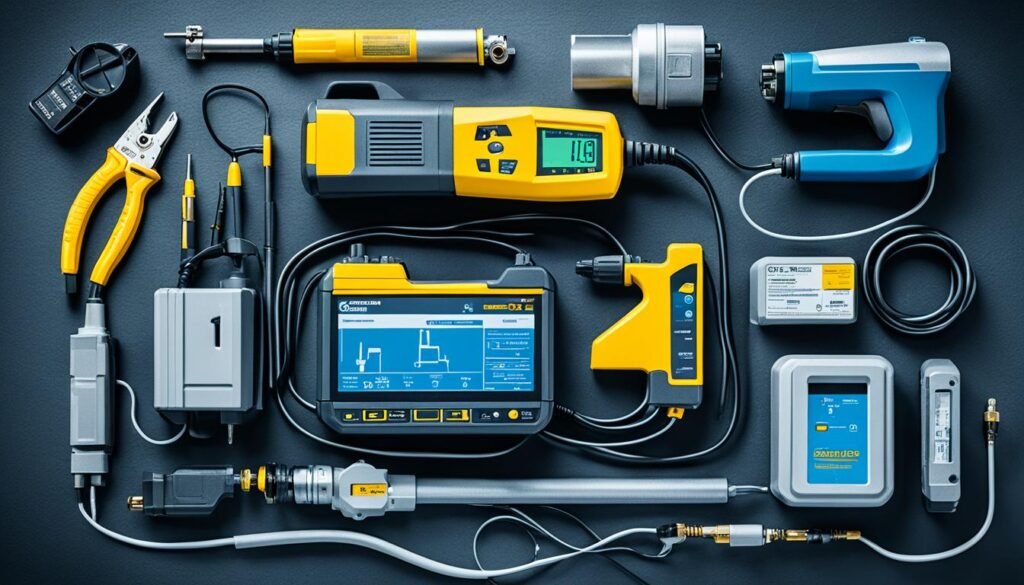Imagine a small roof leak that goes unnoticed. It can lead to thousands in damages.
Water leaks can hurt your property by causing structural issues and mold. Catching and fixing roof leaks early is key. Luckily, there are now advanced technologies that make finding leaks accurate and quick.
High bills and mold signal a water leak. Also, peeling paint and damp spots should alarm you. Thanks to modern technology, finding water leaks has never been easier or more precise.
Professionals use many methods to find roof leaks accurately. These include:
- Thermal imaging: This uses infrared to find moisture by showing temperature differences.
- Ultrasonic leak detection: It listens for water leaks with ultrasonic waves. This finds leaks hard to see with the eyes.
- Acoustic leak detection: This method finds hidden leaks by analyzing sounds.
- Ground penetrating radar (GPR): GPR sends radar pulses to show what’s under the roof, finding leaks.
- Drone imaging: Drones take high-quality pictures of the roof to spot leaks.
- LiDAR (Light Detection and Ranging): Uses lasers to map the roof in 3D, helping find leaks.
- Video pipe inspection: This looks inside pipes and gutters for leaks, using cameras.
While these methods are effective, it’s best to hire a professional. They save time and prevent more damage to your property.
Key Takeaways:
- Ignoring water leaks can cause big problems, making quick detection vital.
- Today’s roof leak detection tech is more precise and efficient.
- Look out for higher bills, mold, peeling paint, and damp areas.
- Methods to find leaks include thermal imaging, ultrasonic and acoustic detection, GPR, drones, LiDAR, and video inspection.
- It’s wise to use a professional for accurate detection and repair.
Different Types of Electronic Leak Detection Technologies
Electronic leak detection (ELD) is a top way to find roof leaks. It’s more accurate and efficient than old methods. You’ll find two main types: high voltage and low voltage.
The high voltage method works best on dry roofs. It uses electrical current to find leaks. This is great for big roofs.
The low voltage method needs a wet membrane and less power. It checks electric fields to spot leaks. This works for all roof types, especially in moist areas.
Both methods have limits. High voltage needs a conductive roof base. Low voltage needs a non-conductive roof cover. But there are new solutions.
One fix is using alternative grounding media. Things like steel and aluminum meshes help high voltage work on non-conductive bases. TruGround is a primer that makes non-conductive roofs ready for high voltage tests.
Conductive glass felt lets the low voltage method work on any roof. It has fibers that find leaks.
Automated leak detection systems offer non-stop monitoring. They use sensors and algorithms to catch leaks fast. This helps fix leaks quickly to avoid more harm.
For tests, roofs can be split into grid division for green roofs. This means breaking the roof into smaller parts for easier leak finding and fixing. It makes spotting and fixing leaks more straightforward.
Advantages of Electronic Leak Detection Technologies
Electronic leak detection has many benefits:
- It finds leaks early, saving money and avoiding big repairs
- It provides constant monitoring for peace of mind
- It works with many roof types and materials
- It exactly locates leaks
- It helps roofs and buildings last longer
- It’s used in various industries, like hospitals and museums
Using advanced leak detection helps avoid the cost and hassle of water damage. It finds leaks early, protecting the roof and building.

Conclusion
Advanced leak detection tech brings huge benefits. These high-tech methods spot leaks quickly and accurately. They find problems before they harm your roof and building.
This tech is a smart investment. It stops costly repairs caused by water damage. It gives you peace of mind, too. You’ll avoid structural harm and mold, saving both time and money.
Leak detection isn’t just for homes. It’s key in hospitals, data centers, museums, and more. These places need to keep water damage away.
With this tech, your property is safe from water troubles. Investing in it means you protect your space. You save money and keep your property in top shape for the future.
